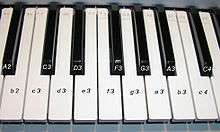Keyboard tablature

A keyboard tablature is a tablature for a keyboard instrument such as the piano. The most common keyboard tablature is written using letters and numbers that designate the timing and keys to hit on a keyboard or piano.
Modern piano tablature is based on scientific pitch notation, a variation of letter notation which has roots going back to the 11th century when Italian Guido of Arezzo developed Solfege.
Piano tab notation
An example of modern piano tab notation, the scale of F played on 2 octaves:
3|--------c-d-e-f-| 2|f-g-a-A---------| 2|--------c-d-e-f-| 1|f-g-a-A---------|
Some of the rules for this keyboard tablature are:
- The numbers on the left (3, 2, 2 and 1 in the above example) indicate the octave. All octaves start on the c key. Octave 4 is in the middle of the keyboard (starting on c4, or middle C).
- Lowercase letters (a, b, c, d, e, f, g) indicate the note names as natural (white keys).
- Uppercase letters (A, C, D, F, G) indicate the note names as sharp (black keys). Using the hash symbol # is also acceptable (A#, C#, D#, F#, G#) but not recommended because it takes extra space.
- The | symbols separate measures or sections of notes.
- The - symbols are used for spacing.
Another example of piano tab notation, the chords E, F, and G:
E F G 3|---|-c-|-d-| 2|-b-|-a-|-b-| 2|-G-|-f-|-g-| 2|-e-|---|---|
Periodic system
Another keyboard tablature (though less frequently seen) is based on a periodic system of numbers, like most modern tablatures, although incorporating negative and positive numbers assigned to the clefs (as positive for the treble clef and negative for the bass clef). This particular method uses the middle C as the reference point. Unlike many tab forms the keyboard tab has far different placement values, meaning, regardless of the arrangement of the numbers it can still have the same value, but is displayed differently.
Visual example
12 12 12 12 12 12 12 12
07 07 07 07 09 09 09 09
04 04 04 04 04 04 04 04
0 0 0 0 0 0 0 0
-12 -8 -7 -5 -3 -3 -3
P-----------X P-----------X
(a basic C, Am/C, progression)
How to compile
The numbers are projected and arranged by value. The particular number is placed in the corresponding column; however, columns are "pushed upward" when notating chords. This "column" system is not affective of the tab itself, more so the appearance, thus it is basically irrelevant.
- Column 4 = Double digit positive numbers (10+)
- Column 3 = Double digit positive numbers (0-09)
- Column 2 = Single digit negative numbers (-1,-9)
- Column 1 = Double digit negative numbers (-10+)
Special notations
- A grace note is shown using smaller numbers as the grace notes, relative to basic music notation. Example: 0 05 12
- A glissando is shown with the start location of the gliss and the stop location. Example: 32------0
- A tremble, rapid alternating between two notes, is indicated with equals signs. Example: 5=====12
- Pedal use is indicated with the P and X characters. This shows when the pedal is held (---) and when released (X). P-------X
- An inaudible or hard to hear note is indicated with parenthesis. Example: (12)
See also
External links
- How to read piano tabs, the basics
- How to read tabs - Additional explanation of modern piano tablature
- Ultimate tab lesson - Advanced piano tablature by Tabologist 'Da Tickler'